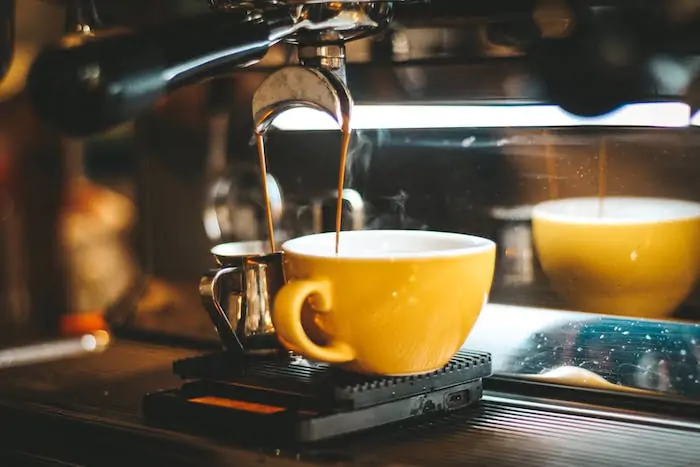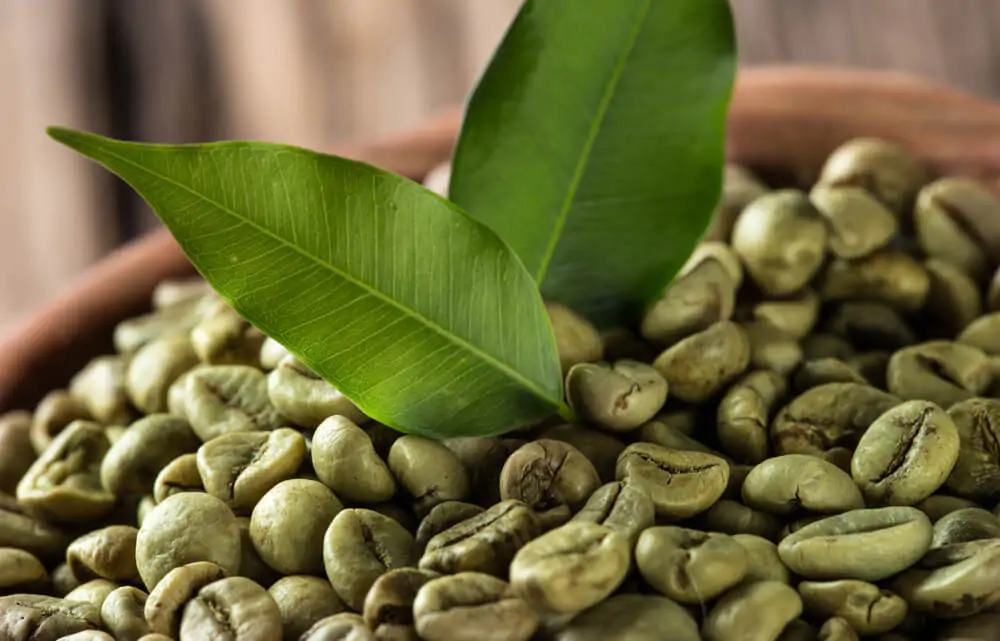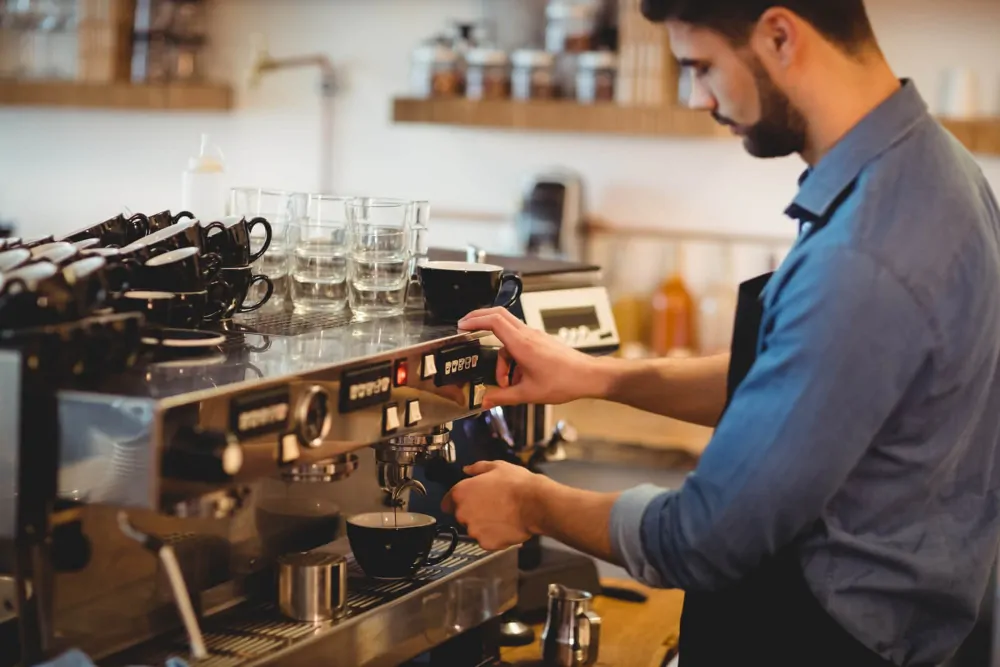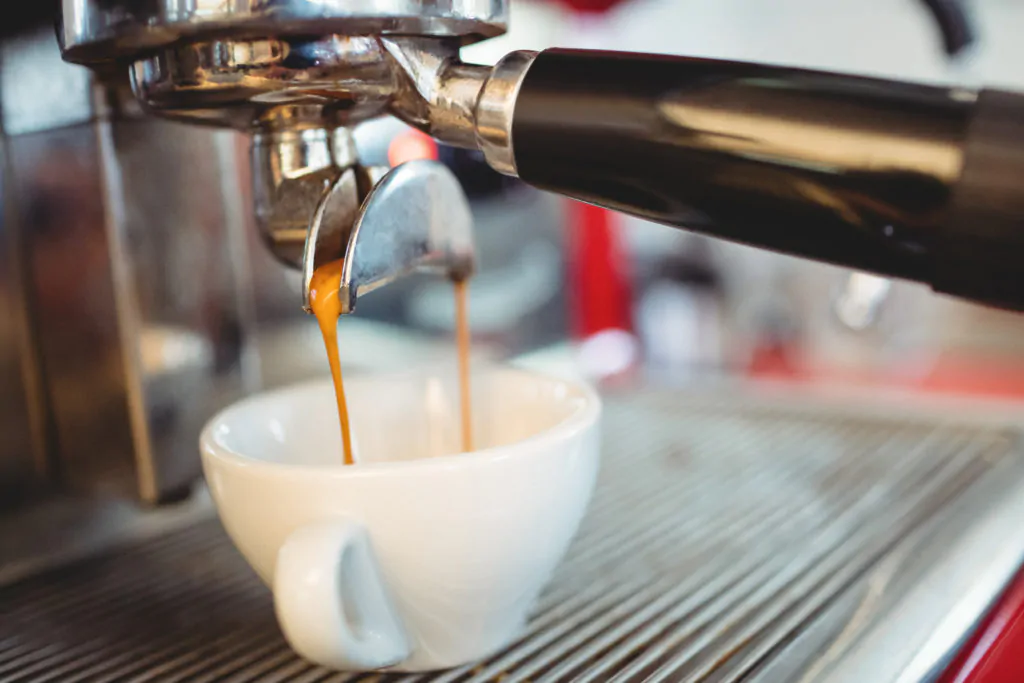Many people ask me, ‘why does my espresso taste sour’ so this article answers this question and helps you make that perfect cup of balanced coffee.

If you are a regular espresso drinker, I am sure you have experienced those bad coffee days. It’s when your favorite cup of Joe tastes sour like lemon instead of the dark chocolate and caramel tones. This leaves a dry and puckers feeling in the mouth, similar to when you eat an unripened fruit.
My friends often ask me, ‘why does my espresso taste sour.’ The ‘sour’ taste in your coffee is a sign of a poorly made brew, and it comes from the tannic acid that occurs naturally in the coffee beans. When the grind is too coarse, it results in extraction, and the fruity acids are released first.
Known as tannic acid, the sourness resulting from this acid should not be confused with the pleasant flavors and bright notes of sharpness and vibrancy in a cup of coffee. Citrus fruits also contain similar compounds, but the acids found naturally in fruits taste pleasant.
For the sour notes in espresso to taste good, they need to be balanced with sweet flavors that are released later in the extraction process. Under extracted coffee lacks sweet tones. Hence you get sour and bitter notes that leave a bad taste in the mouth. To understand this better, read on to find out the extraction process of coffee in detail.
- The Extraction Process Of Coffee
- Common Reasons For Coffee Tasting Sour
- 7 Ways To Fix Sour Coffee
- Cleaning The Espresso Machine
- Deep Cleaning Your Espresso
- Consider Trying A Different Coffee Brand
- Espresso Tasting Burnt Or Bitter
- Solutions For Other Types Of Coffee-Tasting Sour
- Why Does My Espresso Taste Sour: Related Questions
Want a FREE bag of coffee? Start your Atlas Coffee subscription and claim yours today. Cancel any time.
The Extraction Process Of Coffee
The process of extraction starts when hot water comes in contact with the ground coffee to force out the authentic flavor compounds. It refers to everything that grounds released into the water. Interestingly, these compounds are not released at once, and the extraction process takes place at different levels.
Various compounds are extracted at different points during the brewing process and follow the same order each time. Fats and acids that produce sour and oily flavors are extracted first. Next comes the natural sugars meant to balance the taste with their sweetness. This is the point when an experienced barista will stop the extraction process.
If the brew continues to extract beyond this point, it will result in over-extraction of the grounds, and you will end up with bitter plant fibers in your coffee. So, the duration or brew time plays an important deciding factor in determining the taste of coffee between the two unwanted opposite ends of the spectrum.
To strike the sweet spot when pulling an espresso shot, ensure your extraction process lasts only 25 to 30 seconds. For ideal results, use a finer grind that will make it difficult for the hot water to pass through. You may consider using a larger dose but be careful not to over-extract your coffee as it may turn bitter/ burnt.
If you pour your espresso shot in less than 15 seconds, this will result in under-extracted coffee that appears pale, blonde, and bubbly. There will be a light layer of crema on the top that will dissipate quickly. The brew looks not only unimpressive but also tastes sour and lifeless.
Common Reasons For Coffee Tasting Sour
I have already mentioned the biggest reason or factor for a sour espresso sour. However, there may be a few other reasons other than under extraction. Read on to learn about the common reasons that make your coffee taste off.
You Used Single-Sourced Beans
As a coffee lover, I am sure you will agree that coffee beans’ quality and roast level impact your brew’s flavor and taste. The single-sourced beans have recently become a popular choice for espresso, and this helps baristas lend an authentic flavor to the drink.
The biggest downside of single-sourced coffee beans is that they contain a much higher acidity level, making your coffee sour or bitter. On the other hand, coffee blends lose a considerable amount of acidity when processed and roasted. If you use single-sourced beans for brewing and end up with a sour espresso or bunt cup of mud every time, consider switching to a coffee blend that includes a dark roast.
You Are Using The Wrong Roast
If your espresso tastes acidic, this could be because you are using the wrong type of roast. Sour flavor often results when you use coffee beans with light roast to brew your cup of Joe. Furthermore, the beans that are still green and fresh taste sour when brewed because they have not had the time to degas.

Espresso tastes best when you use a medium roast a week after they have been roasted so that they get enough time to settle in. If you don’t want your coffee to taste sour, consider using a darker roast that can release rich caramel notes to your brew.
Shots Pulled At Low Temperature
One of the common reasons why your espresso tastes sour is because you pulled it at a very low temperature. Pulling a shot at low-temperature results in under-extraction because the cold water molecules are not active enough to perform a complete extraction. Hence, you end up with a sour and acidic taste.
Inspect your espresso machine to ensure that the water forced through the system is hot enough to result in the full extraction process. Ideally, the water should be around 201 degrees F, just below the boiling point when pulling an espresso shot.
Allow time for the machine to warm up the water to get the perfect brew. Also, remember that the water temperature can lower if you pull several shots at a time.
Consistency Of The Grind
Check the consistency of the coffee ground you use for making coffee. If it’s too coarse, then the hot water runs through the extra-large spaces without properly extracting the full flavors. There need to be a few seconds of contact time between the grounds and hot water to be able to get the balanced flavors in your cuppa.
To ensure a good contact time, grind the beans finer than creating a slight restriction and delaying the hot water from passing through it. With a finer grind, you will reduce the molecules’ spaces and avoid under-extraction as water takes time to pass through.
Smaller Dose Of Coffee Grounds
If you use a significantly smaller dose than the accepted standard as per the weight of coffee in the portafilter, this may result in the brew tasting sour. Check to see if you have taken a lower quantity of coffee grounds as this will cause the water to pass quickly without restriction and fewer grounds means fewer coffee oils.
To prevent this, use a larger dose of coffee grounds so that there is a good amount in the portafilter to create resistance to hot water. Thus, the contact time between coffee grounds and hot water increases, resulting in the full extraction of the good flavors.
7 Ways To Fix Sour Coffee
Now that you have learned about the common reasons behind ‘why does my espresso taste sour,’ let’s take a look at ways to fix this problem. Yes, luckily, the early morning woes about coffee gone bad and tasting off can be fixed with little tweaks. Here are the seven main ways to influence extraction quality.
1. Adjust The Size of Coffee Grinds

Check your grind size and if it’s too coarse, consider re-grinding the ground coffee to a fine texture. Getting the right grind for each roast, bean, and region is an important aspect of brewing the perfect coffee. If your grinder is unable to give you a fine texture, consider investing in new equipment.
2. Correct the Brewing Time
The brewing time has a great impact on the quality of the brew and enhances the extraction process. When pulling an espresso shot, give it an average brewing time of 25-30 seconds. Anything less will result in under extraction and more will give you overly extracted burnt coffee.
3. Select the Right Coffee-to-Water Ratio
The coffee-to-water ratio usually controls the amount of flavor in your cup. When pulling an espresso shot, the amount of water is predetermined by the machine. However, there are some infusion methods in which the amount of water in the grounds can be balanced to avoid a sour or bitter flavor.
4. Check the Water Temperature
Chemistry says that every chemical reaction doubles in intensity with every 10 degrees Celsius increase in temperature. This implies raising the temperature will result in an increase in the extraction process. However, be careful because too hot water may give you a burnt or bitter taste.
5. Adjust the Wet Dose
This can be a good alternative to get the right flavor despite the grind size. The recommended ratio for coffee to wet dose is 1:2. So for every 10 gms of coffee in the portafilter, you will need to extract 20 grams of yield. Pulling longer shots ensures that hot water and grounds stay in contact for longer.
6. Adjust the Dry Dose
Making minor adjustments in the dry dose can also significantly improve your espresso flavor. You may increase the dry dose by using more grounds when brewing the same amount of coffee. Each ground may be a little less extracted, but overall the flavor will be well-adjusted.
7. Clean Your Espresso Machine
Another good way to ensure that your espresso always stays spot-on when delivering flavor is to make sure you clean it after every use. A clean machine is a happy machine, and there’s absolutely nothing denying that. Let’s discuss the ways of keeping it clean below:
Cleaning The Espresso Machine

At times, the sour and bitter flavors in your coffee are due to an unclean machine. Hence it makes sense to take care of your investment. Old coffee oils and grounds stuck inside the group head and portafilter can degrade the flavor of your espresso. Hence, cleaning and taking good care of your espresso after every use is important.
Experts recommend cleaning the machine after every single shot. Rinse the portafilter in running water until it turns clear to remove any stubborn grounds stuck inside. Now, take a soft cloth and wipe the portafilter to ensure that it’s free of any ground particles.
When you are done with using your espresso for the day, you actually have a few more cleaning options. If your espresso machine includes a three-way overpressure valve like this, do a quick backflush to clean the entire system and all pipes.
Now, attach the blank portafilter and run the water for about ten seconds. Discard and rinse. Repeat this at least 4 times. Run water for one last time and then wiggle the empty portafilter in the main group head. If the machine lacks any valve, follow the product manual’s cleaning instructions.
- Rugged Brushed Stainless Steel housing
- Commercial three-way solenoid valve. Capacity water tank - 2,1 liter
- Commercial-style 58mm chrome-plated brass portability and brew group
- Commercial steam wand. Rotating steam want movement type
- Easy-to-use rocker switch controls
Deep Cleaning Your Espresso
To ensure that you get the best flavors every time, you will need to show your machine some loving care with a quality espresso cleaner that can dislodge the grounds and break apart coffee oils. For deep cleaning, soak the dispersion screen and portafilter, and screw with the liquid dishwasher for 10 minutes.
Rinse with clean water and wipe everything with a dry cloth or rag. If your espresso machine has a 3-way overpressure valve, perform the backflush routine using a cleaner when the portafilter is blank.
Consider Trying A Different Coffee Brand
If you have tried all of the above but still struggle with a sour espresso, consider changing the brand of coffee beans you use. Some harvesters tend to mix the ripe and not very ripe coffee cherries in the same bag, resulting in inconsistent flavors as they roast at different times.
As a result, I recommend you try different coffee brands to find out which one suits your tastes. Espresso is a tough horse to tame, but this is what makes it so interesting and rewarding to make. Keep trying with your honest efforts to get shots that will blow away your mind.
Espresso Tasting Burnt Or Bitter
A cup of espresso tasting burnt or bitter instead of sour refers to the other side of the spectrum when coffee grounds are over-extracted. The bitter taste is akin to ginger or medicine. Although it takes longer for bitterness to develop in a cup of espresso, it can overpower your cuppa.

The most common reason behind the dark and bitter pours is slow dripping, and sometimes that would mean just a small volume of brew even after a 45-second extraction time. The puck will appear loose and soggy.
By over-extraction of coffee grounds, we mean that hot water flows through the grinds slowly, resulting in a longer contact time. This results in a brunt, bitter, and harsh-tasting espresso. Other reasons include too fine coffee grounds that make it hard for water to flow through, tamping the coffee grounds too much, and overfilling the basket.
If you notice a sudden change in the flavor of your espresso and it tastes burnt, adjust the grinder settings to give you a slightly coarse grind. This will ensure that water seeps through the grind evenly, without a lot of resistance or overcooking the grounds.
Solutions For Other Types Of Coffee-Tasting Sour
You know the answer to ‘why does my espresso taste sour,’ but what if you brew a pour-over coffee or French Press one day, and it tastes sour too? Here are a few quick fixes for different styles of coffee to ensure that you enjoy great-tasting coffee each and every time.
French Press Coffee
If your coffee extracted through the French Press method tastes sour, check to ensure that you give it at least four minutes of brewing time. You may need a finer grind than what you are already using, but be careful because this is slightly tricky. Too fine may clog the mesh and make your cup muddy with many sediments, so adjust slowly to find the sweet spot.
Cold Brew Coffee

Cold brew coffee tastes heavenly, but it should not be sour. To ensure that let the grounds steep just enough so that there are no under-extraction issues. It is also possible that you are not using enough grounds, so stick to the 1:4 or 1:5 coffee grounds to water ratio for a cold brew.
Pour Over Or Drip Coffee
If your drip coffee turns out to be sour, this could be due to a coarse grind. Make the grounds finer until you are able to achieve a more balanced flavor. Also, increase your drawdown or extraction time from 15 seconds to 30 seconds to rule out under extraction and get a full-bodied flavor.
Aeropress Coffee
If your coffee made in an Aeropress tastes bitter, try a finer grind to allow hot water to fully extract the sweet notes that balance out the acidic flavors. You may also consider doing an inverted Aeropress method to get a full-bodied flavor.
Recommended Coffees
| Brand | Details | Price | Buy Now |
|---|---|---|---|
 | Recommended! Try the tastiest coffee from around the world. Sent straight to your door. Cancel any time. | From $9 per month | Try now |
 | Premium coffee from Hawaii | From $22 | Save With a Triple Pack |
 | High performance coffee drinks | From $24.95 | Shop now |
Why Does My Espresso Taste Sour: Related Questions
How is a true espresso supposed to taste?
True espresso is supposed to have a rich caramel-like taste with sweeter notes, not sour like an unripened fruit. The brew was probably under-extracted if the sour taste makes your mouth pucker.
How much coffee grounds do you use for a cup of espresso?
If you are making a single shot of espresso, you will need to use at least 6-8 grams of coffee, and for a double shot, you will require about 14-16 grams. If the quantity of coffee grounds used for making espresso is not enough, you will end up with a sour-tasting brew.
Why is my espresso salty?
Single sourced coffee beans that have a lighter roast may often lend a sour taste to your coffee. Most of the beans that are sourced from Indonesia fall under this group. It is also possible that the espresso is under-extracted, the water is not hot enough, or the beans are too stale or fresh.
What is the ideal extraction rate for an espresso coffee?
If you have heard about the extraction percentages and the total dissolved solids (TDS) percentage, then this is primarily how the brew is extracted from coffee grounds, and the TDS is usually 18–22%. However, bear in mind that this is just an average, and the TDS may vary for different types of coffee.
How do I know if my espresso is bitter or sour?
If your espresso is bitter, your coffee will likely appear pale or yellow, and your puck will be soggy and sloppy. This often happens when your extraction or pour time is too long. If your espresso is sour, it is likely to gush out, pale and bubbly, and your puck will be dry and crumbly. This means your espresso shot is under-extracted.


